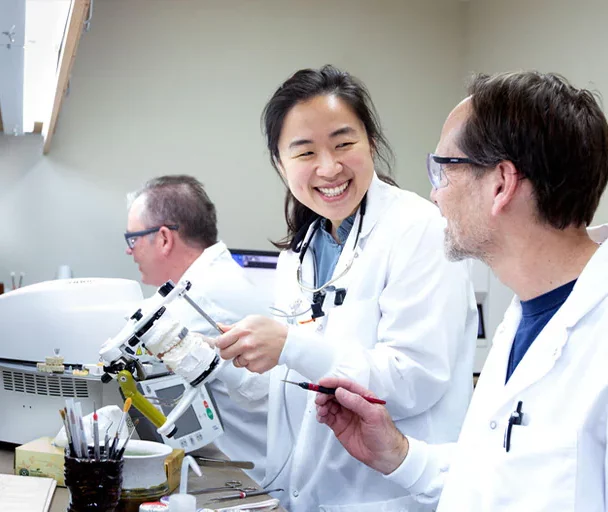Introduction
- Overview of Dental Implants:
- Explanation of what dental implants are and why they have become the preferred solution for replacing missing teeth.
- Brief overview of the procedure of getting a dental implant, including the process of osseointegration, where the implant integrates with the jawbone.
- Importance of Proper Care and Prevention:
- The significance of caring for dental implants properly to ensure their longevity and function.
- Highlighting the importance of preventing peri-implantitis, a condition that can lead to implant failure if not addressed properly.
- Thesis Statement:
- This essay will explore how peri-implantitis can be prevented and offer a detailed guide on how to care for dental implants effectively, ensuring their success over the long term.
1. Understanding Peri-Implantitis
- What is Peri-Implantitis?
- Definition of peri-implantitis: an inflammatory condition that affects the tissue surrounding the dental implant, leading to bone loss.
- Difference between peri-implantitis and peri-mucositis (a less severe inflammation confined to the soft tissue around the implant).
- Causes of Peri-Implantitis:
- Bacterial infection as the primary cause: how plaque accumulation and poor oral hygiene can lead to bacterial buildup around the implant.
- Risk factors: smoking, diabetes, poor oral hygiene, genetic predisposition, and prior periodontal disease.
- The impact of poor surgical technique, improper positioning, or poorly maintained implants in the early stages.
- Symptoms of Peri-Implantitis:
- Signs of infection: swelling, redness, bleeding when brushing or flossing, and discomfort around the implant.
- Advanced symptoms: mobility of the implant, visible bone loss on X-rays, and bad breath or an unpleasant taste in the mouth.
- Consequences of Untreated Peri-Implantitis:
- Bone loss around the implant, leading to instability and eventual implant failure.
- The risk of further complications if left untreated, including the need for implant removal or additional surgeries.
2. Importance of Preventing Peri-Implantitis
- Preventing Implant Failure:
- How peri-implantitis is one of the leading causes of dental implant failure, and why preventing it is crucial for implant longevity.
- The difference between successful and unsuccessful implants is often rooted in the patient’s commitment to proper care.
- The Role of Early Detection:
- The importance of regular dental checkups to detect early signs of peri-implantitis before it becomes severe.
- X-rays and clinical assessments used to monitor the health of dental implants over time.
- Quality of Life Considerations:
- Maintaining the functionality and aesthetics of dental implants as they directly affect a patient’s ability to speak, chew, and maintain facial structure.
- The impact of implant failure on a patient’s self-esteem and overall oral health.
3. How to Care for Dental Implants
- Oral Hygiene Practices:
- The foundation of preventing peri-implantitis: maintaining a clean environment around the dental implant to avoid bacterial accumulation.
- Brushing and Flossing:
- How to properly brush dental implants, including using soft-bristled brushes and non-abrasive toothpaste to avoid damaging the implant surface.
- The role of flossing and special implant-friendly floss or interdental brushes in keeping the area around the implant clean.
- Use of Antimicrobial Mouthwash:
- How antimicrobial mouthwashes can help reduce bacteria around the implant and prevent infection.
- Professional Cleanings:
- The importance of regular professional cleanings every 3-6 months to remove plaque and tartar buildup that can’t be removed through at-home care.
- How dental professionals use special tools designed for cleaning around implants to avoid damaging the sensitive tissues.
- Dietary Considerations:
- The impact of diet on implant health: avoiding sticky, hard, or overly sugary foods that can contribute to plaque buildup or put stress on the implants.
- Recommended foods for healthy gums and bone density (e.g., calcium-rich foods, antioxidants, and vitamin D).
- Quit Smoking:
- The detrimental effects of smoking on implant success and the increased risk of developing peri-implantitis in smokers.
- The effect of tobacco on blood circulation and the healing process after implant placement, as well as its role in encouraging bacterial growth.
4. Preventive Strategies for Peri-Implantitis
- Adhering to Post-Surgical Instructions:
- Following the dentist’s post-surgical care instructions after the implant procedure to reduce the risk of infection and promote healing.
- Avoiding unnecessary strain or trauma to the implant site during the initial recovery period.
- Regular Follow-Ups and Checkups:
- The importance of keeping scheduled follow-up appointments after the implant placement, typically within the first few months and then periodically.
- What dentists look for during checkups to detect any signs of peri-implantitis, including swelling, infection, or bone loss.
- Proper Implant Design and Placement:
- How ensuring proper placement of the dental implant during the surgical procedure can prevent misalignment that could lead to plaque accumulation.
- How implant materials and designs can play a role in preventing bacterial buildup, with smooth and non-porous materials being preferable.
- Maintaining Healthy Gums:
- Keeping the gums surrounding the implant healthy through regular oral hygiene and possibly using special gum care products.
- The role of gum grafting or other treatments in patients with gum recession that could expose the implant or reduce the tissue seal.

5. Role of Technology in Preventing Peri-Implantitis
- Advancements in Implant Design:
- Innovations in dental implant technology, such as surface treatments, that reduce plaque buildup and improve the integration of the implant with the bone.
- New materials that are more resistant to bacterial growth and improve the long-term stability of the implant.
- Early Detection with Imaging:
- The role of X-rays and 3D imaging in detecting early signs of peri-implantitis, including bone loss or infection that may not be visible to the naked eye.
- How digital tools, including intraoral cameras and laser diagnostics, can aid in monitoring the health of dental implants.
- Laser Therapy for Treatment:
- The potential use of lasers to treat peri-implantitis by removing infected tissue and promoting healing without causing harm to the surrounding bone.
- The advantage of lasers in providing more precise and minimally invasive treatment options for peri-implantitis.
6. Treatment Options for Peri-Implantitis
- Non-Surgical Treatment:
- When peri-implantitis is caught early, non-surgical treatments like scaling and root planing (similar to deep cleaning) may be sufficient.
- The use of antimicrobial agents or laser therapy to target and remove bacterial infection while preserving the implant.
- Surgical Treatment:
- When peri-implantitis is more advanced, surgical interventions may be necessary, such as flap surgery to access and clean the infected area and bone grafting to restore lost bone.
- How bone regeneration techniques, like guided tissue regeneration, can be used to restore the bone structure around the implant.
- Antibiotic Therapy:
- How systemic and localized antibiotics can help manage bacterial infections and prevent further tissue damage.
- The potential drawbacks and limitations of antibiotic use in treating peri-implantitis.
7. Long-Term Care and Maintenance of Dental Implants
- Establishing a Maintenance Routine:
- Developing a long-term care routine that includes regular checkups, home care, and lifestyle modifications to ensure the ongoing success of dental implants.
- Patient Education and Awareness:
- The importance of educating patients about the risks of peri-implantitis and how to spot the early warning signs.
- Providing patients with clear instructions on how to care for their implants and the importance of consistency in their oral hygiene routine.
Conclusion
- Summary of Preventive Measures and Care Tips:
- A recap of the critical points discussed regarding preventing peri-implantitis and maintaining good oral hygiene to ensure the longevity of dental implants.
- Final Thoughts on the Importance of Prevention:
- Emphasizing the value of proactive care and regular checkups in ensuring that dental implants serve their purpose for many years.
- The overall impact of proper dental implant care on a patient’s quality of life, dental health, and long-term satisfaction with their implants.













































Discussion about this post